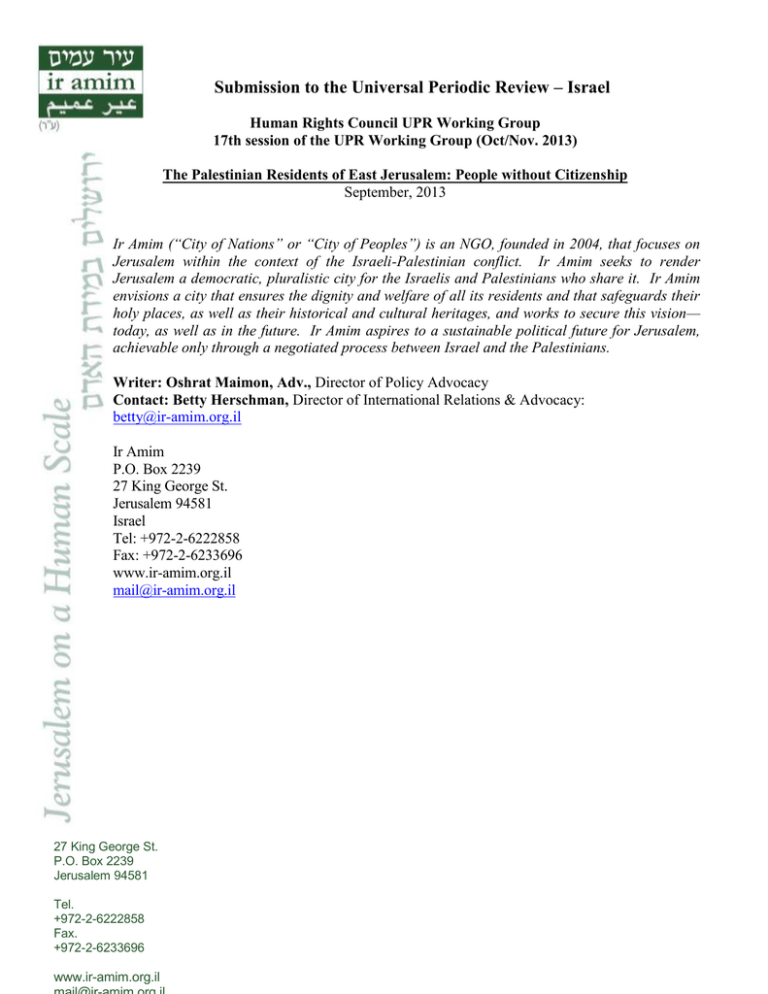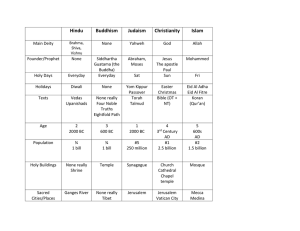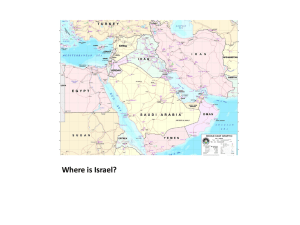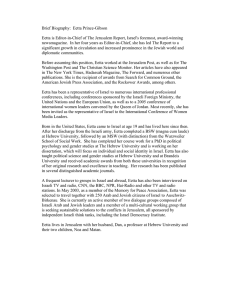Submission to the Universal Periodic Review – Israel
advertisement

Submission to the Universal Periodic Review – Israel Human Rights Council UPR Working Group 17th session of the UPR Working Group (Oct/Nov. 2013) The Palestinian Residents of East Jerusalem: People without Citizenship September, 2013 Ir Amim (“City of Nations” or “City of Peoples”) is an NGO, founded in 2004, that focuses on Jerusalem within the context of the Israeli-Palestinian conflict. Ir Amim seeks to render Jerusalem a democratic, pluralistic city for the Israelis and Palestinians who share it. Ir Amim envisions a city that ensures the dignity and welfare of all its residents and that safeguards their holy places, as well as their historical and cultural heritages, and works to secure this vision— today, as well as in the future. Ir Amim aspires to a sustainable political future for Jerusalem, achievable only through a negotiated process between Israel and the Palestinians. Writer: Oshrat Maimon, Adv., Director of Policy Advocacy Contact: Betty Herschman, Director of International Relations & Advocacy: betty@ir-amim.org.il Ir Amim P.O. Box 2239 27 King George St. Jerusalem 94581 Israel Tel: +972-2-6222858 Fax: +972-2-6233696 www.ir-amim.org.il mail@ir-amim.org.il 27 King George St. P.O. Box 2239 Jerusalem 94581 Tel. +972-2-6222858 Fax. +972-2-6233696 www.ir-amim.org.il Ir Amim - Submission to the Universal Periodic Review – Israel, Human Rights Council 17th session of the UPR Working Group (Oct/Nov. 2013) The Palestinian Residents of East Jerusalem: People without Citizenship Ir Amim is pleased to submit this report to the Human Rights Council UPR Working Group, ahead of its 15th session regarding Israel. This report focuses on one of Ir Amim’s primary policy foci— the fact that 300,000 Palestinians living in Jerusalem do not have full civil status, contrary to international law, and the consequences of their status on their enjoyment of basic human rights. 1. The application of international law to the residents of East Jerusalem 1.1. At the end of the 1967 war, Israel applied its law to East Jerusalem. Therefore, according to domestic Israeli law, East Jerusalem is like any other part of Israel. 1.2. International law does not recognize the unilateral annexation of East Jerusalem. According to international law, the laws of belligerent occupation apply to East Jerusalem and its residents are protected persons. As such, Israel is obligated to protect their rights, which are enshrined in humanitarian international law. One of the basic principles of international law is that use of force cannot transfer or change sovereignty. 1.3. However, even according to Israel, the basic rights enshrined in Israeli law apply to East Jerusalem and its residents, as do its obligations under international human rights law; including those set forth in the 1948 Universal Declaration of Human Rights, the 1966 International Covenant on Civil and Political Rights (ICCPR) and the International Covenant on Economic, Social and Cultural Rights. 2. The civil status of the residents of East Jerusalem 2.1. At the end of 2010 the Palestinian population of Jerusalem was 283,900 out of a total of 788,100 residents of Jerusalem (36%).1 According to Jerusalem Municipality figures, at the end of 2011 the Palestinian population of Jerusalem was 360,880 out of a total of 933,133 residents of the city (38.7%). 2.2. After the 1967 war, Israel conducted a population census in the area it annexed as East Jerusalem. The census determined the eligibility of the Palestinians living in East Jerusalem to receive Israeli identity cards, which they required in order to continue living in the city. Without identity cards, they were unable to maintain contact with the authorities, even to receive basic services. 2.3. Israel did not offer or allow universal citizenship to all Palestinian residents of East Jerusalem. At no point did it offer the Palestinians collective citizenship. 2.4. The Citizenship Law, 1952, does not grant universal citizenship to the residents of East Jerusalem. The law does provide for the possibility of obtaining personal individual citizenship, but it does not apply universally to all residents of East Jerusalem, nor have the residents of East Jerusalem traditionally been interested in exercising the personal option. Furthermore, such naturalization involves pledging allegiance to the State of Israel, a demand that contradicts international law. 2.5. According to the interpretation in Israeli case law of the Entry into Israel Law, 1952 (the Awad case),2 the residents of East Jerusalem are considered to have received a license for permanent residency, based on the recognition of those who were counted in the population Central Bureau of Statistics figures, Table 2.5, “Sources of Population Growth, by Type of Locality, Population Group and Religion.” The Jerusalem Institute for Israel Studies cites similar but slightly higher figures in its publications. 2 HCJ 282/88 Awad v the Prime Minister and Minister of the Interior, PD 45(2) 424 (1988). 1 1 census conducted in the area in 1967. The status of residency was actually forced on the residents of East Jerusalem, given that refusing to receive resident status would have resulted in the denial of their right to continue living in their homes and to conduct normal life in the place where they were born and lived, as well as exposing them to the threat of deportation. 2.6. The Palestinian residents of East Jerusalem do not have the fundamental civil right to vote or be elected for central Israeli government institutions. They cannot vote or run for the Israeli Knesset3 and do not carry Israeli passports.4 They are entitled to vote and run in the municipal elections for the Jerusalem Municipality, 5 but cannot run for the position of mayor.6 In practice, most of the Palestinians of East Jerusalem prefer to boycott the elections as an expression of their refusal to accept Israeli rule and of their affinity with the Palestinian nationality. 2.7. There are additional restrictions in other laws that limit the election of certain positions in Jerusalem solely to Israeli citizens: for example, “a person who is not an Israeli citizen" cannot serve as a board member or executive member of the Jerusalem Development Authority. 7 2.8. The residents of East Jerusalem participated in elections for the Palestinian Authority's Legislative Council and presidency and were given the right to vote and run for office. The Israeli government defended its decision to allow their participation in the High Court of Justice, in accordance with the Oslo accords it had signed. But according to Israeli law, the Palestinian Authority (PA) is precluded from operating in Jerusalem and therefore cannot operate in the place of East Jerusalemites’ residency8. That might explain, at least partially, the poor voter turnout in East Jerusalem—the lowest in the country, at only 30%. 2.9. Therefore, Palestinian residents of East Jerusalem are not full citizens of any country. While they are carriers of Jordanian passports, they have not been full Jordanian citizens since 1988. They have the status of permanent residency in Israel but are not Israeli citizens. They have Palestinian identities and can vote for the Palestinian authorities, but do not have Palestinian passports (unlike residents of the West Bank). 3. Violation of the right of residents of East Jerusalem to return to their country and violation of their freedom of movement 3.1. According to international law, people have the right to return to their home country. 3.2. Contrary to that assertion, under Israeli law East Jerusalemites’ residency in Israel—unlike citizenship—must be constantly proven and is always subject to expiration and revocation. 3.3. By the Entry into Israel Ordinances a license of permanent residency will expire if the license owner leaves Israel and settles in a country outside of Israel. A person will be considered to have settled in a country outside of Israel if one of the following conditions is met: s/he stayed out of Israel for at least seven years; s/he received license to reside in another country permanently; or s/he received the citizenship of that country. 3.4. In the Awad case, the court went as far as to rule that a license of permanent residency could expire even without an "external" act of revocation. 3 Sections 5 and 6 of Basic Law: The Knesset. Sections 2 of the Passport Law, 1952. 5 Local Authorities Law (Elections), 1965. 6 Local Authorities Law (Election of Authority Head and Deputies and their Tenure), 1975. 7 Article 11 of the Jerusalem Development Authority Law, 1988. That authority has broad powers concerning the planning and development of Jerusalem. For example, by government decision, it received NIS 50 million in each one of the budget years 2006-2013 for the development of the Old City basin. 8 The Law for the Implementation of the Interim Agreement concerning the West Bank and the Gaza Strip (Restriction of Operations), 1994; Section 6 of Basic Law: Jerusalem the Capital of Israel (Law Book 1760, December 7, 2000). 4 1 3.5. The status of residency is interpreted in Israel as one that requires constant proof that the "center of one's life" is in Jerusalem. For these purposes, even the West Bank and Gaza Strip are considered "outside of Israel". Accordingly, the residents of East Jerusalem were actually denied the possibility of leaving Jerusalem for long periods in order to acquire education or secure work, for example, out of fear of losing their status and entitlement to live in East Jerusalem. 3.6. Since 1967, the Interior Ministry revoked the residency of more than 13,000 people. 4. Violation of the right of the residents of East Jerusalem to family life 4.1. In 2002 the Israeli government decided to suspend the naturalization procedures of a Palestinian couple. That suspension led to the extensive violation of the right to family life of tens of thousands of Israeli citizens as well as residents of East Jerusalem. 4.2. The Citizenship and Entry into Israel Law (Temporary Order), 2003 excluded Palestinian spouses from being eligible for the normal graduated procedures for the legalization of the status of spouses of Israeli citizens and residents. This order denied, among other things, the possibility of family reunification between a spouse who is a resident of East Jerusalem and his or her Arab partner, if the non-resident male spouse was under the age of 35 or the female spouse was under the age of 25. The same applied to the couple's minor children over the age of 14. 4.3. The Supreme Court rejected petitions against the temporary order, after it was repeatedly extended and even expanded, by a majority of 6:5.9 The temporary order has been extended until January 31, 2013 and can be expected to be extended again at that time. 4.4. The temporary order adversely affects thousands of Israeli citizens and residents of East Jerusalem and their Palestinian spouses. In the case of the residents of East Jerusalem, if one’s spouse is a resident of the West Bank (or residents of Iran, Lebanon, Syria, Iraq or Gaza) they cannot obtain licenses to reside in Israel or permits to stay in Israel. As a result, some of the couples live in forced separation. In other cases, the Palestinian spouse resides in Israel with temporary permits that do not permit him/her to work or drive; moreover, the non-resident spouse cannot be insured by the National Insurance Institute or enjoy public health care. If residents of East Jerusalem choose to live in the Occupied Territories with their spouses, they risk losing their resident status and everything it entails. 5. Discrimination in East Jerusalem residents’ exercising of rights 5.1. This section does not aim to address all the areas in which the rights of residents of East Jerusalem are severely violated—only to offer evidence to that effect. 5.2. The absence of citizenship status severely harms the ability of Palestinian residents of East Jerusalem to influence the procedures that regulate life in the place they reside. East Jerusalem is a city of physical, social and budgetary neglect, forsaken by the Israeli authorities in every facet of life. 5.3. The poverty rate and intensity of poverty in the Jerusalem district were the highest in Israel in 2010. The poverty level of Arab families in Jerusalem is three times higher than that of Jewish families and the overall poverty rate in East Jerusalem is a staggering 78.4%.10 5.4. Violation of the right to housing 5.4.1. The Israeli planning policy in East Jerusalem is driven almost exclusively by considerations of maintaining a solid Israeli majority in the city. As a result of residents 9 HCJ 5030/07, 830, 544, 466 (11/1/2012) The National Insurance Institute, "The Dimensions of Poverty and Social Gaps, 2010,” (November 2011). 10 1 having so few legal options, there are currently approximately 20,000 buildings in East Jerusalem built without permits. 5.4.2. Living conditions in East Jerusalem are overcrowded and harsh.11 In 2010, the housing density in East Jerusalem was the highest in Israel, twice that of the general population of Israel.12 There is currently a shortage of 10,000 housing units for the Palestinian population living in East Jerusalem. The shortage is expected to grow by some 1,500 housing units each year. On the other hand, the level of home demolitions in East Jerusalem is unprecedented. Since 1967, it is estimated that some 2,000 houses have been demolished in East Jerusalem.13 5.5. A serious situation in neighborhoods within the boundaries of Jerusalem according to Israeli law but located beyond the separation barrier 5.5.1. Eight neighborhoods in East Jerusalem lay completely within the boundaries Israel declared in 1967 as the jurisdiction of Jerusalem, but the separation barrier has left them on the other side of the barrier. As soon as the barrier was built, municipal services all but disappeared from these neighborhoods, which became crowded and neglected enclaves where city officials dare not set foot. Some 70,000 Palestinian residents of Jerusalem currently live in these centers of poverty and are required to pass through checkpoints each time they want to enter their own city. For many, having to cross a checkpoint is a daily requirement. 5.5.2. The Israeli national and municipal enforcement agencies rarely enter these areas. The situation has led to a tremendous building boom, conducted in the absence of even minimal infrastructure. Emergency services and other basic vital services the city is obligated to provide barely exist in these neighborhoods. The building density and absence of infrastructures and services have created areas on the verge of a humanitarian disaster, whose residents are left to struggle in a “no man’s land” all but completely cut off from municipal services and the city itself. Since the barrier was built, these residents have faced an additional threat: that Israel will realize an unspoken intention to completely and permanently disconnect them from the city. 5.6. Violation of the right to education 5.6.1. Despite the state's obligation to provide free education, thousands of children in East Jerusalem remain outside of the education system every year. Years of neglect of the Arab education system in Jerusalem have resulted in a severe shortage of classrooms14, classroom overcrowding, inadequate educational facilities and extremely high dropout rates. Because of this deficit, thousands of children are relegated to private or unrecognized schools, requiring their parents to pay exorbitant costs in order for their children to receive the "free" education to which they are entitled by law. 5.6.2. More than 4,300 Arab children are not enrolled in any educational institution. The dropout rate at the high school level is about 50% of students15. The extreme shortage of classrooms for children in East Jerusalem led the Supreme Court to strongly criticize the authorities.16 There is also deep discrimination in the current administration budgets of the public schools in East Jerusalem, as well as in professional personnel standards. 11 Hamoked and ACRI petition (HCJ 2797/11), section 28. Table 5.23 in the Israel Statistical Yearbook, No. 62 (2011). 13 OCHA, “East Jerusalem: Key Humanitarian Concerns,” (December 2011). 14 There is a shortage of 1,000 classrooms in East Jerusalem – According to the State Comptroller, Annual Report 59b (May 2009), p. 624. 15 An inconceivable rate compared to any other place in Israel .Yuval Wargen, “Education in East Jerusalem,” Knesset Research and Information Center, 2006, [Hebrew], p. 13. 16 HCJ 5373/08 Abu Libdeh et al. v. Minister of Education et al. (from February 6, 2011). 12 1 5.7. Violation of the right to social security 5.7.1. The welfare system in East Jerusalem suffers from years of underfunding and discrimination compared to West Jerusalem and in fact is on the verge of collapse. Despite the staggering poverty rate of more than 78%, only a small percentage of the residents of East Jerusalem are served by the welfare system and the standard positions allocated to them are only half of what they are entitled to by the size of the population, even without taking into account the glaring poverty rate. The number of standard positions allocated to the welfare bureaus in East Jerusalem is the lowest in all of Jerusalem; there are only three bureaus in that sector, compared to 20 in West Jerusalem. 1






